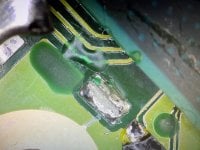Hello,
I installed a Picofly a few days ago in my Switch. After a few hours of work I finally booted it up and got the “no sd card” screen as expected.
Unfortunately, I quickly discovered some serious issues. Attempting to boot Hekate just gives a black screen, and holding vol +/- to boot from OFW gives a blue screen.
The chip itself glitches perfectly on first attempt, I’ve reinstalled it and very carefully checked all solder points to no avail. Removing the chip fully again leaves me with a blue screen on boot.
Now — after searching for a solution, I tried booting a UMS payload, and to my surprise it worked; supposedly because it runs solely off the APU’s iRAM instead of the dedicated RAM, but I have no reason to think my RAM is the issue. I didn’t touch it.
Advice would be greatly appreciated.
I installed a Picofly a few days ago in my Switch. After a few hours of work I finally booted it up and got the “no sd card” screen as expected.
Unfortunately, I quickly discovered some serious issues. Attempting to boot Hekate just gives a black screen, and holding vol +/- to boot from OFW gives a blue screen.
The chip itself glitches perfectly on first attempt, I’ve reinstalled it and very carefully checked all solder points to no avail. Removing the chip fully again leaves me with a blue screen on boot.
Now — after searching for a solution, I tried booting a UMS payload, and to my surprise it worked; supposedly because it runs solely off the APU’s iRAM instead of the dedicated RAM, but I have no reason to think my RAM is the issue. I didn’t touch it.
Advice would be greatly appreciated.






 hmmm I'm a terrible pirate lol
hmmm I'm a terrible pirate lol